Modern customers strive for efficiency and independence. They don’t want to wait to hear from support, scroll to find an answer to their question, or be proven that your product is the best. They want assistance here and now, with as much quality as possible.
For many businesses, the solution to this has been the introduction of self-service.
But—
How effective is self-service? What businesses benefit from it the most? And do customers prefer self-service?
This article will provide answers to these and other questions, providing you with relevant self-service statistics and forecasts.
Let’s explore!
Learn how to provide excellent customer self-service with the help of AI
Let’s start with some essential definitions.
What is customer self-service?
Fundamentally, customer self-service entails equipping customers with the tools to assist themselves, allowing them to independently address their concerns rather than requiring communication with your support team.
It should be mentioned that self-service comes in many forms. Here are some examples:
- Chatbots acting as virtual assistants that can handle any issues and questions, as well as smoothly guide customers through the purchasing process
- Self-service product training where customers can educate themselves on the product and reach their “Aha!” moment independently
- Discussion forums where customers can communicate with other users and find answers to their questions within the community
- Extensive and up-to-date knowledge bases and help centers to assist customers in solving problems and learning how to use products
- Customer portals where users can complete their tasks and update information
This list is ever-growing: more new self-service platforms and tools are appearing, and customer self-service is becoming a true necessity rather than a buzz.
And, more importantly, it’s definitely not what you think when you consider a classic customer support portal. To give you an idea, here is an example of a customer service chatbot:
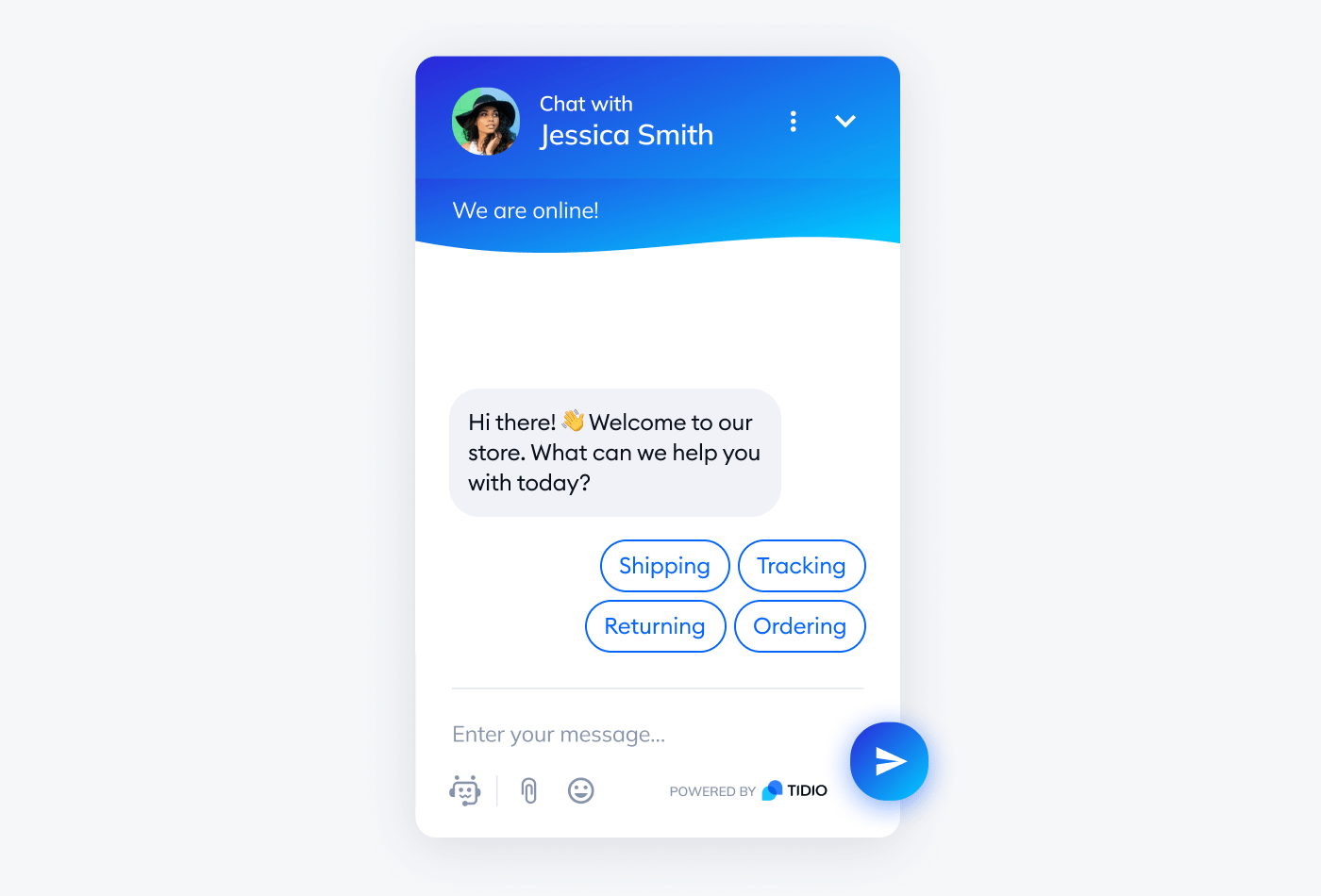
Read more: Need some inspiration? Check out our article on customer self-service tips and best practices. Or, have a look at Tidio knowledge base for all kinds of information about our products and services.
It’s safe to say that customer self-service has proven to be a truly efficient model of customer service and support.
However, a very important question remains—
Do consumers like self-service?
They do! In fact, over 67% of customers prefer using a form of self-service rather than talking to a customer service representative. As many as 73% prefer using the company’s website exclusively instead of social media, SMS, or live chat apps for support.
This says a lot about who current consumers are—independent, demanding, and, well, tech-savvy!
What are some other arguments in favor of self-service?
Let’s unpack this.
Benefits of customer self-service
Introducing self-service will bring you more than just a few new tools to use. If done right, the benefits are immense. Let’s explore some of the most prominent ones.
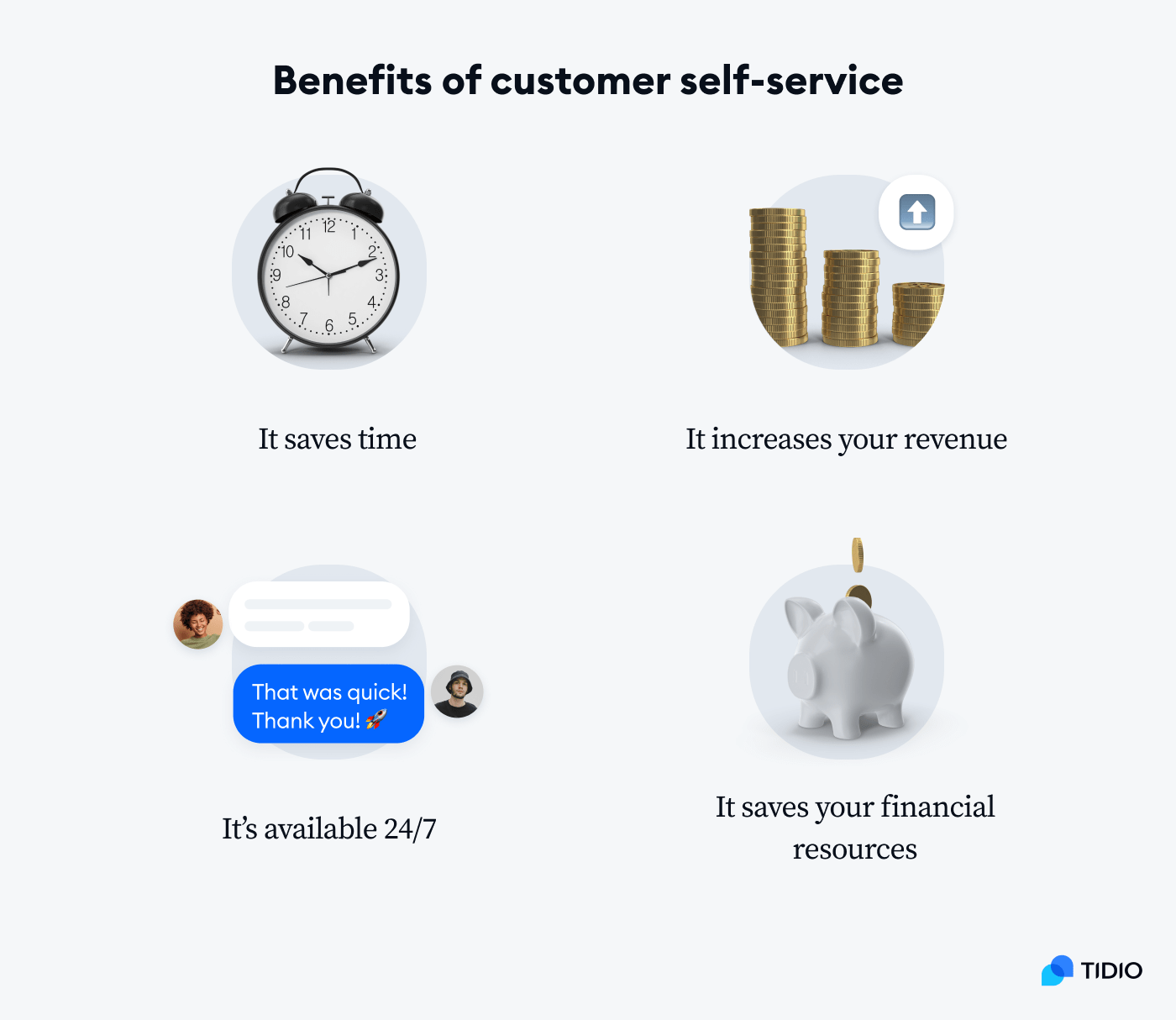
1. Self-service saves time
Efficient self-service empowers your clients to instantly discover solutions and answers without the need to linger for assistance from customer support. This is a significant advantage. In fact, as many as 73% of clients agree that the most important thing a company can do for them is value their time. Self-service helps businesses do so like never before.
2. Self-service helps businesses save money
It’s hard to overestimate the financial impact of introducing intelligent self-service solutions. It costs close to nothing compared to employing a team of support agents big enough to provide fast and quality assistance.
Of course, it doesn’t mean that you have to fire people for the sake of self-service—they could work in a powerful unison that will benefit everyone involved. As a result, self-service can help a company save an average of $1-3 million annually. Very impressive, isn’t it?
3. Self-service is accessible 24/7
Unlike humans, self-service support is available on demand 24/7, everywhere and anytime. It doesn’t just mean instant and quality service—it also gives the opportunity to scale your business in different time zones and languages.
About 53% of respondents find waiting too long for replies the most frustrating part of interacting with businesses, and they don’t hesitate to switch to a competitor if the wait is too long. However, with self-service, long wait times can’t happen—even in the night hours.
Read more: Check out our study on chatbot statistics and how they benefit businesses around the clock.
4. Self-service helps you increase revenue
The happier your customers are, the more sales you close. And it really works. In fact, 47% of businesses reported an increase in sales after implementing self-service. These numbers are growing year after year, and more businesses are switching to something that will not only save their money but to help to earn more.
As you can see, the benefits are pretty convincing. How does it look in practice? Is there any real data from businesses that can support the big words?
You’re in good hands!
Let’s turn to the freshest customer self-service statistics to check the industry pulse.
Self-service statistics: overview
Customer self-service is used globally by businesses of all sizes and backgrounds, and its popularity is only growing. It’s fair to say that soon it will become the golden standard for businesses if they want to keep their customers happy and satisfied.
So, what’s the current state of self-service?
Here is all the valuable information and hand-picked statistics about self-service we’ve gathered.
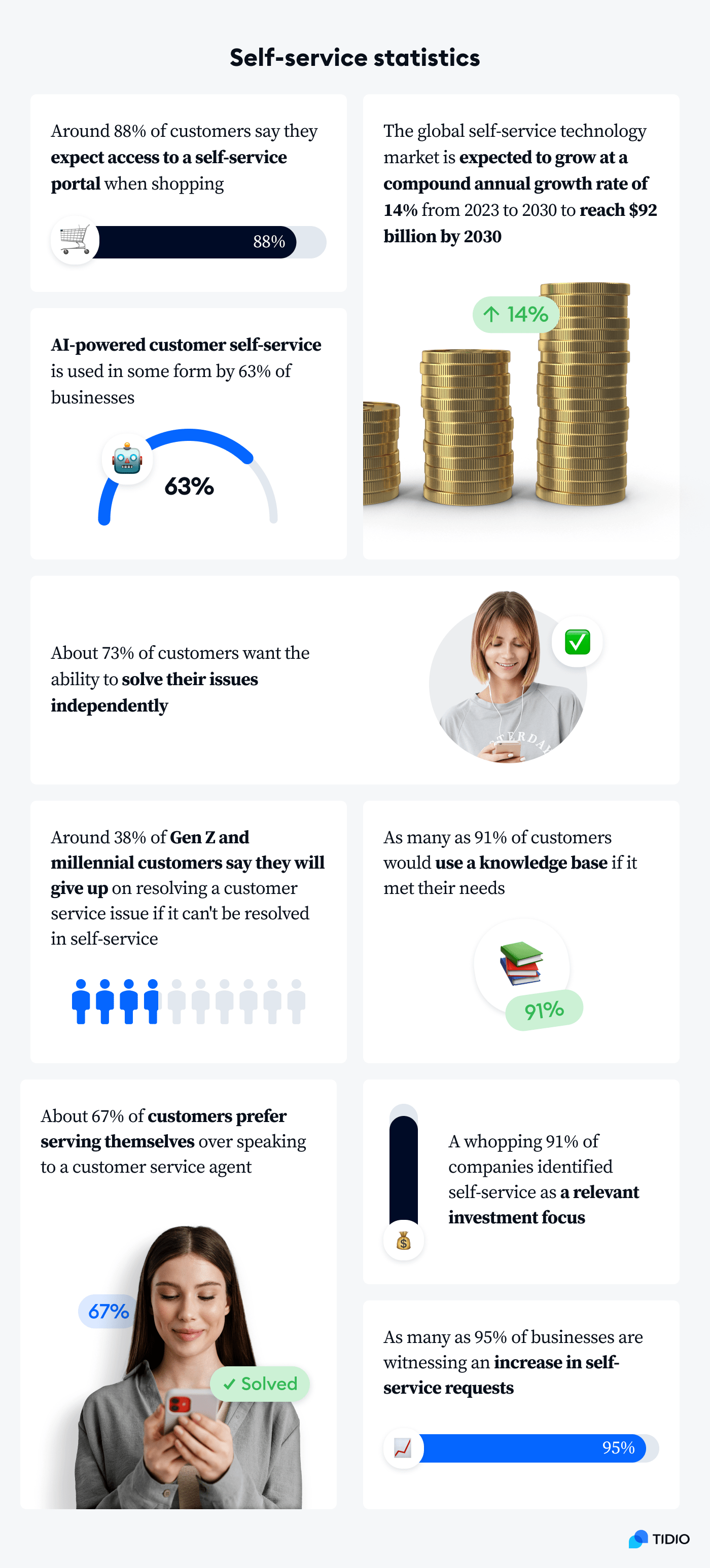
Now, let’s delve further into the statistics.
1. About 88% of customers state they want access to a self-service portal when shopping online
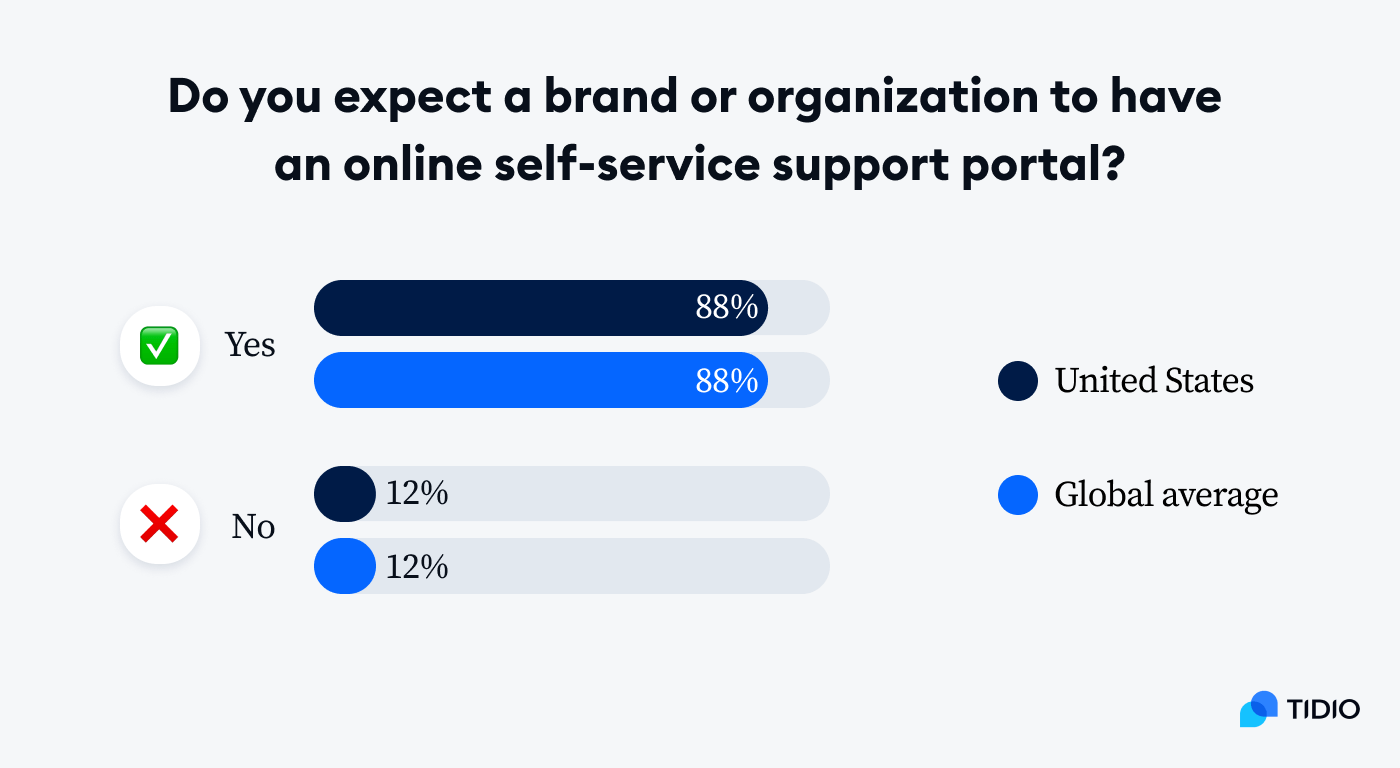
This is huge. Practically 9 out of 10 customers globally would prefer a business to have self-service. For American consumers, the results are exactly the same.
What does it mean for your company? Well, if you ignore this data, almost all customers might move to a competitor. This can be a great sign to mobilize your efforts and prioritize customer self-service installation. Your clients will only become more tech-savvy, so it’s vital to consider installing the tools that will both delight them and help your business handle customer support like a pro.
2. AI-powered customer self-service is used in some form by 63% of businesses
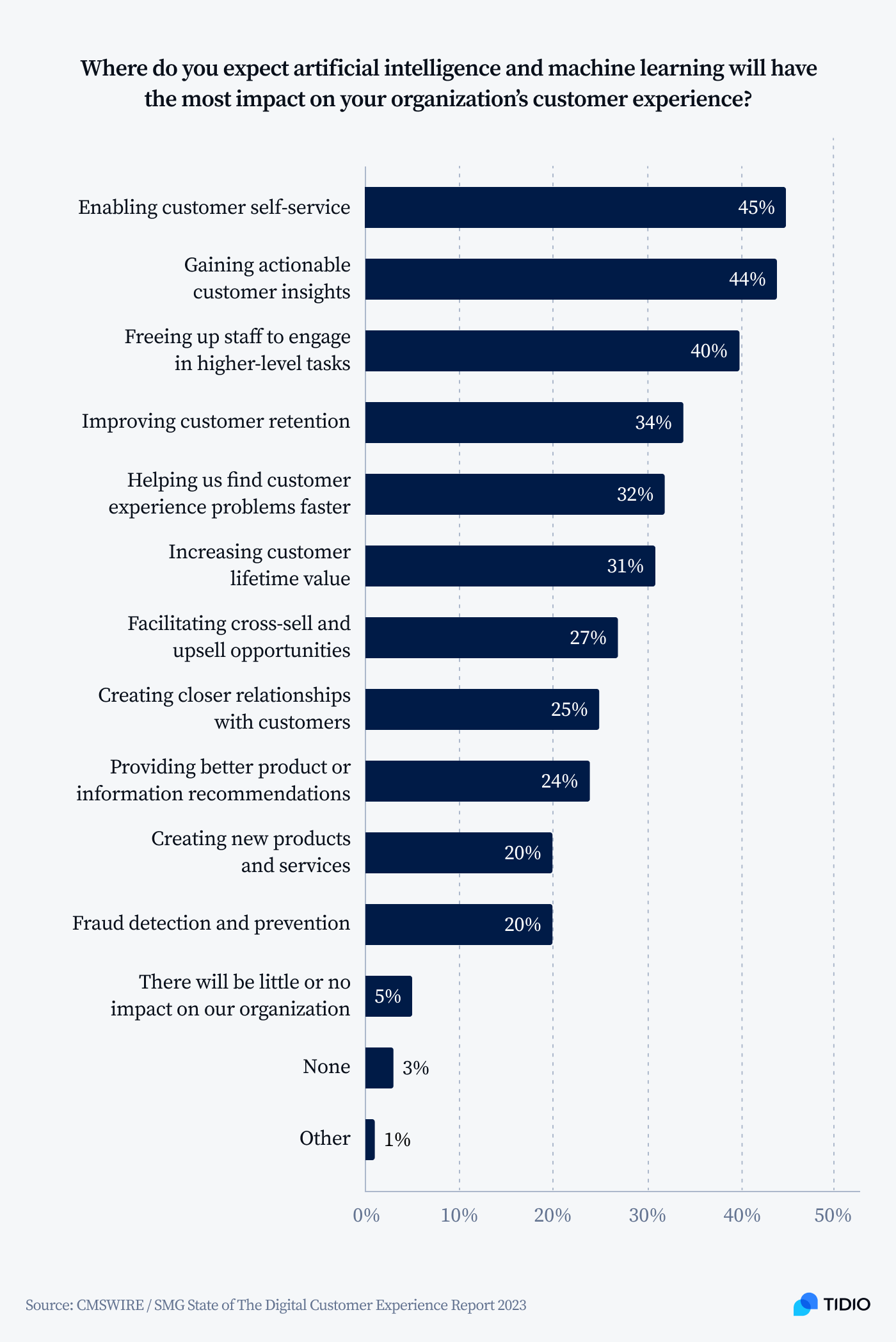
Whether it’s FAQ chatbots, interactive knowledge bases, AI-driven search, or virtual shopping assistants, some form of AI self-service is used in more than half of businesses globally. In addition, 45% of companies expect enabling customer self-service to be the most impactful step for positive customer experience when it comes to AI.
And no wonder: AI tools provide consistent quality service, reduce customer effort, offer data-driven insights, and provide personalization without huge investment from your side. In a world where most of the progress is made by AI technologies, it would be a waste of opportunity not to offer the benefits of AI to your customers.
Read more: Read more about the benefits of installing an AI chatbot.
Learn how to provide excellent customer self-service with the help of AI
3. The global self-service technology market is expected to grow at a compound annual growth rate of almost 14% from 2023 to 2030 to reach $92 billion by 2030
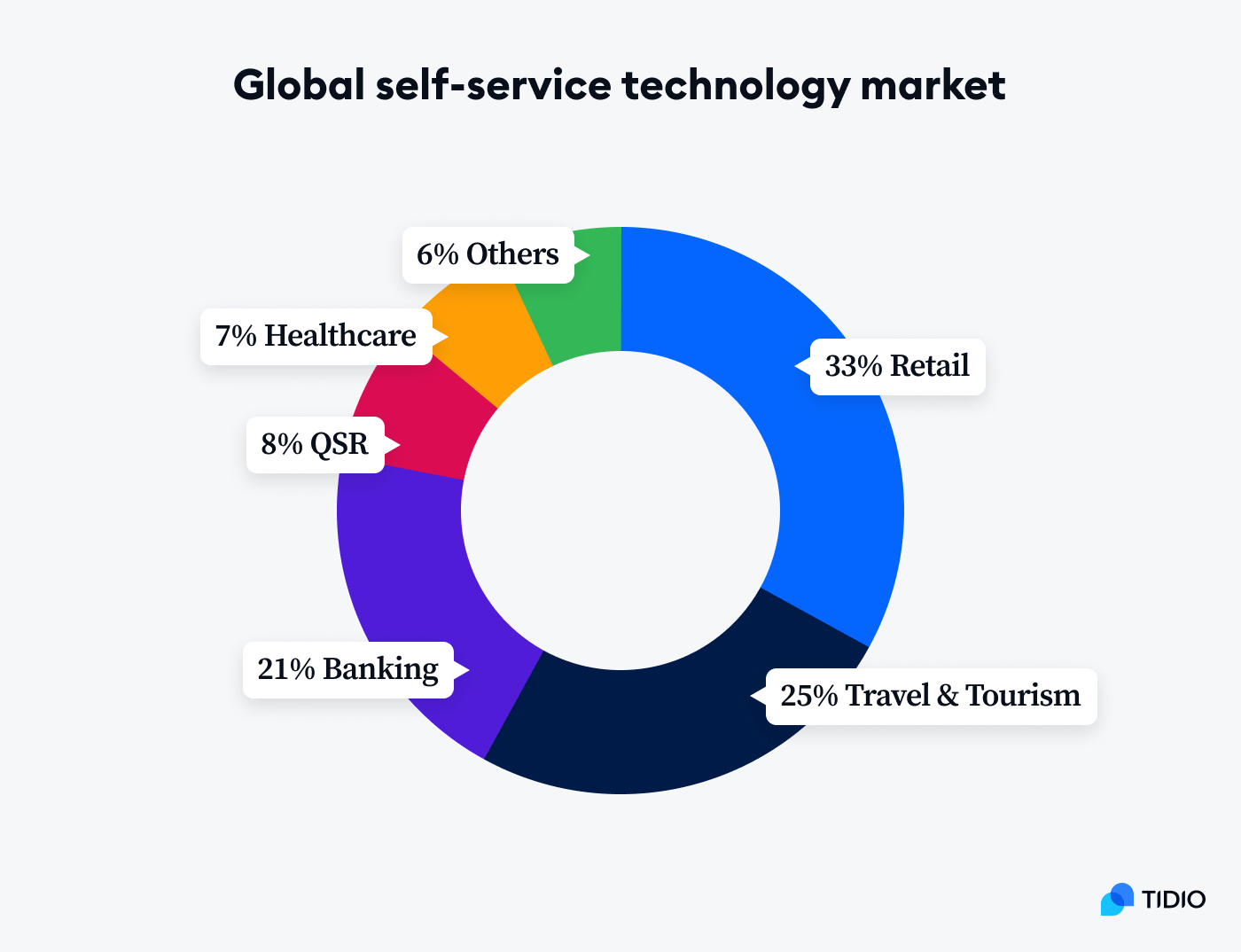
In 2022, the global market for self-service technology reached a value of $34 billion and is projected to experience a compound annual growth rate (CAGR) of 14% throughout the forecast period. It should be mentioned that this number doesn’t include only digital self-service, but the total scope of self-service technology like self-service kiosks, checkouts, and more.
Still, this is a great indicator of the direction retail is moving towards, and ecommerce businesses play a substantial role in it. In fact, retail makes up the biggest part of industries profiting from using self-service technologies, with a revenue share of 33%.
Read more: Discover the most important ecommerce statistics and how you can use them to grow your business.
4. About 73% of customers want the ability to solve their issues independently
Research shows that to a vast group of customers, reaching out to support teams is always the last report. This highlights the fact that customers typically prefer not to engage in direct conversation at all costs and would instead opt for self-service options.
The bottom line? Customer self-service is a great tool to improve client satisfaction and turn your website visitors into paying and loyal customers. You can even prioritize good customer service over pricing: about 48% of consumers believe that the quality customer service is more important than the price.
5. Digital self-service can cut support costs by 75% and dramatically decrease wait times

The benefits of self-service are pretty tangible. It drives down your costs spent on support, empowers your customers to solve their problems independently as they want it, and enhances the overall customer experience on your website.
By reducing the number of online chats, emails, and calls directed to your staff, you are immediately cutting costs and enhancing profits. Research indicates that a live agent call center interaction can range between $6-12, whereas an automated interaction can be as cheap as 25 cents.
Read more: Find out how an ecommerce business hit 85% customer service automation in our case study.
Furthermore, this cost-saving measure allows customer service teams to dedicate their efforts to handling more intricate and valuable customer interactions with a great deal of human empathy. This way, you save time and money for your business without sacrificing any customer satisfaction.
6. As many as 91% of customers would use a knowledge base if it met their customer needs
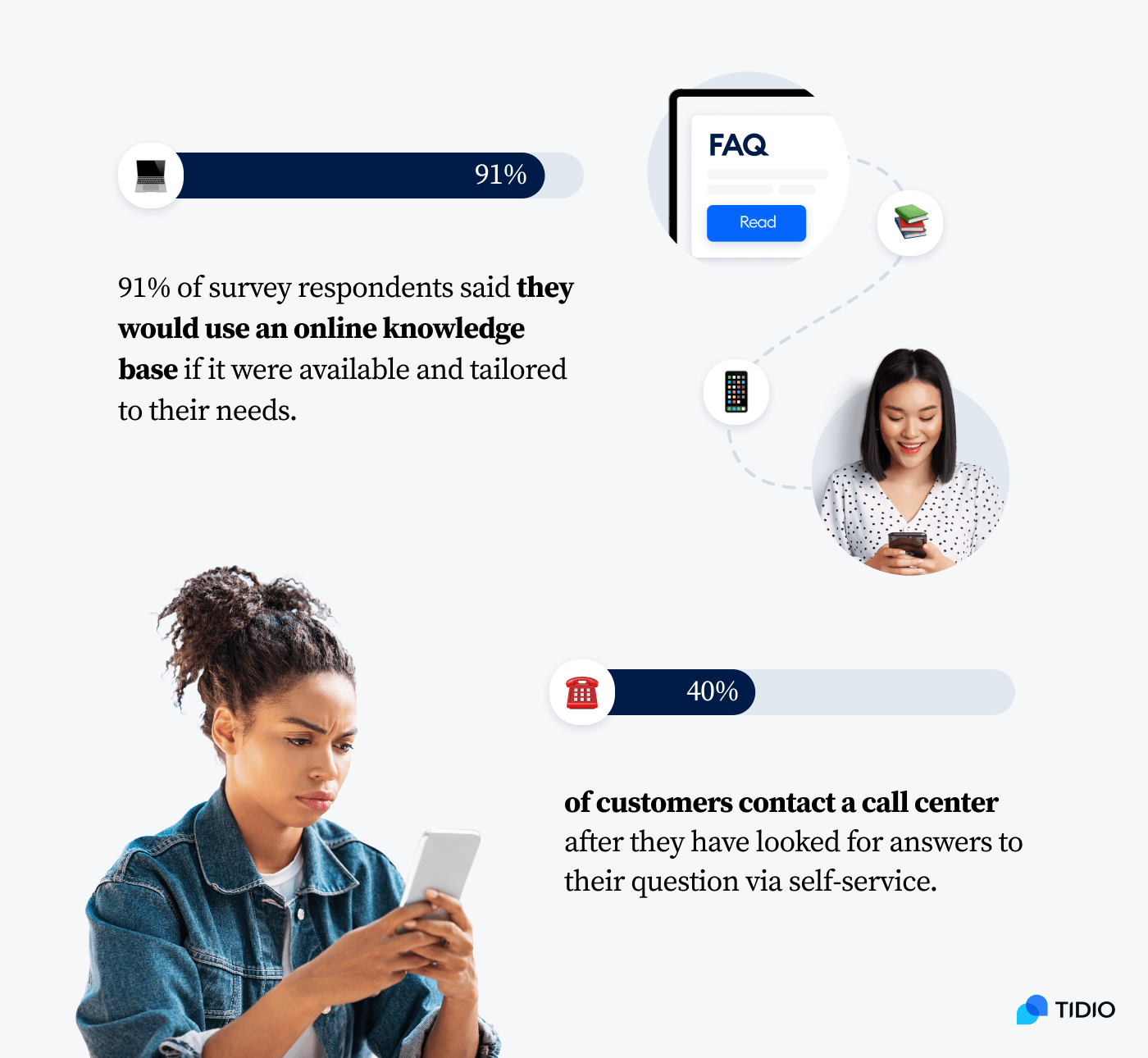
Self-service knowledge bases are a big thing these days. A well-designed and comprehensive knowledge base not only aligns with customers’ preferences for independent issue resolution but also serves as a testament to a company’s commitment to delivering a user-friendly and efficient experience. A good self-service help center would include elements like text, audio, webinars, and graphics.
By addressing the support needs of clients through a self-service knowledge base, businesses can make the purchasing process much more efficient and smooth for their customers.
7. Around 38% of Gen Z and Millennial customers say they’ll give up on resolving a customer service issue if it can’t be resolved in self-service
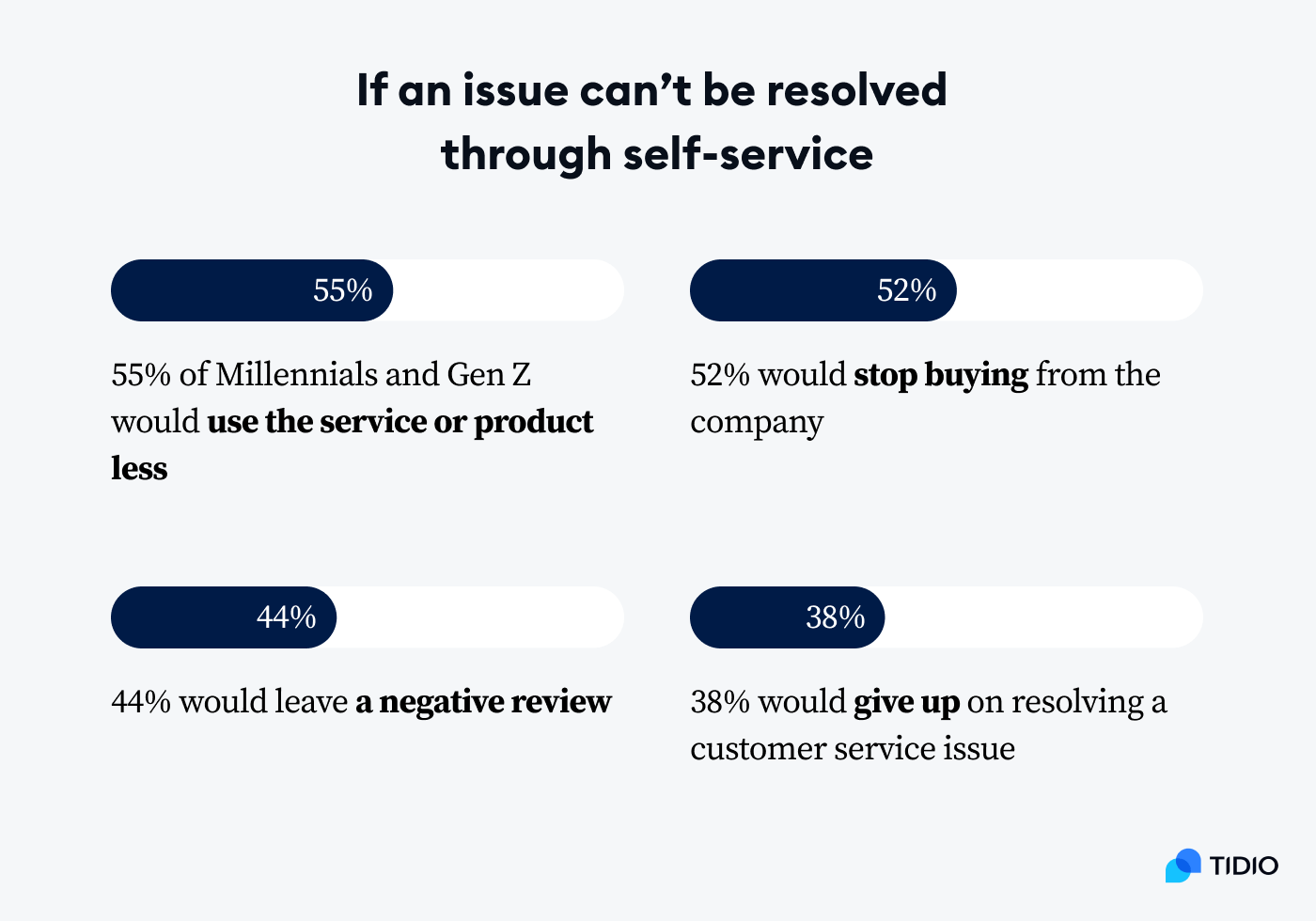
Out of all customer demographics and backgrounds, younger generations (Millennials and Gen Z) are probably the pickiest and most impatient. And this is not a bad thing—they value their time and swiftly abandon those businesses that don’t do the same. They have the mindset of “self-service or no service” when it comes to customer support, and businesses should learn to deal with it. According to surveys conducted among Gen Z and Millennials, a failure to quickly resolve issues through self-service could result in certain consequences:
- 55% would decrease their usage of the service or product
- 52% would refrain from future purchases with the company
- 44% would leave a negative review about the company or its products
The conclusion? The critical importance of self-service solutions in maintaining customer success and satisfaction is evident in these findings, be that for Gen Z and Millennials or any other generation.
8. About 67% of customers prefer serving themselves over speaking to a customer service agent
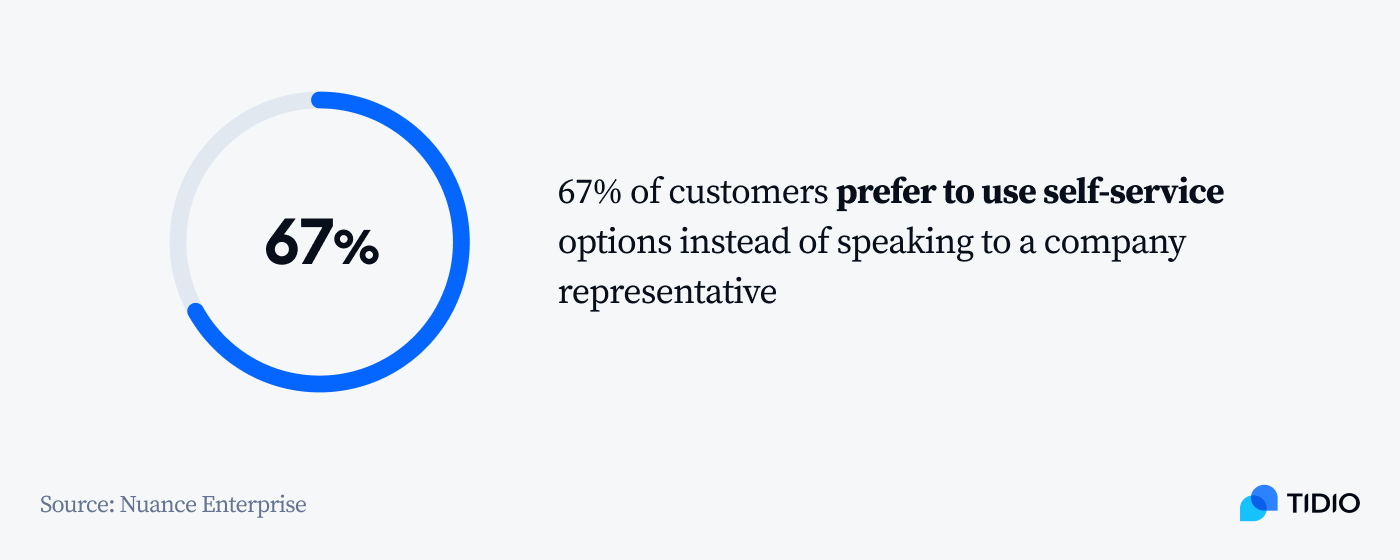
It’s pretty clear at this point that customers don’t just want self-service—they need it. This preference underscores the evolving dynamics of consumer interactions in the digital age. This trend is indicative of a shift towards empowered and independent consumers who value efficiency and convenience. It has become especially relevant during and after the pandemic, and businesses have to reflect this shift.
Self-service options, ranging from online FAQs and automated systems to chatbot platforms and user-friendly mobile apps, allow customers to address their queries and concerns at their own pace, without the need for immediate assistance. This not only aligns with the fast-paced nature of modern life but also lets individuals take control of their user experience.
As technology continues to advance, businesses that invest in and enhance self-service capabilities are likely to meet the expectations of a majority of their customer base, resulting in increased satisfaction, customer loyalty, and other valuable metrics.
9. A whopping 91% of companies identified self-service as a relevant investment focus

But what about the businesses themselves? Well, a whopping 91% of organizations have identified self-service as an important focus for their investment. This overwhelming acknowledgment of self-service pinpoints the transformative power and growing significance of this approach in today’s business environment.
Companies are strategically aligning their resources to develop user-friendly interfaces, intuitive platforms, and customer service automation systems. They recognize that the investment in self-service not only meets customer expectations but also positions them at the forefront of innovation and responsiveness in a rapidly evolving market. It underscores a collective understanding among businesses that embracing self-service is not just a trend but a strategic imperative for sustained success.
Learn how to provide excellent customer self-service with the help of AI
10. As many as 95% of businesses are witnessing an increase in self-service requests

The trend is crystal-clear—the demand for customer self-service will only increase. This statistic serves as a compelling indicator that the demand for self-service solutions is not just a passing trend but a fundamental aspect of modern customer service strategies.
Companies that prioritize and adapt to this shift are likely to enhance customer satisfaction, reduce support costs, and position themselves as agile and customer-centric entities in an ever-changing business landscape. The future of customer service and business is always uncertain. However, we can be sure that self-service is here to stay.
Let’s now sum up everything that has been said about self-service.
Self-service statistics: takeaways
Customer self-service is no longer a “nice thing to have” for businesses. It has become a necessity and a golden standard if one wants to offer great customer service and keep clients happy.
The significance of self-service is highlighted by data and statistics coming from businesses of all kinds. In modern turbulent times, independent problem-solving and minimizing communication with support have become an expectation of the average customer.
The absence of good self-service options may prompt your customers to reach out to your support team. However, it might also motivate them to leave your business altogether.
Embracing self-service is crucial for effectively utilizing your support team’s capabilities while simultaneously providing outstanding service to your customers. It stands as the most efficient route toward achieving this balance.
Sources
- Self service support statistics
- 14 Stats That Make the Case for Self-Service in 2022 | Hubspot
- Kick-Ass Customer Service | Harvard Business Review
- A report on Global State of Customer Service Sophistication | Microsoft
- Adapting to the Customer Service Preferences of Gen Z and Millennials
- Customer Self-Service Statistics 2023– Everything You Need to Know
- Do you expect a brand or organization to have an online self-service support portal?
- Customer Service & CX Research
- The Future of Chatbots: 80+ Chatbot Statistics for 2023
- 14 stats that prove the importance of self-service technology in customer service
- 81% Of Consumers Say They Want More Self-service Options

